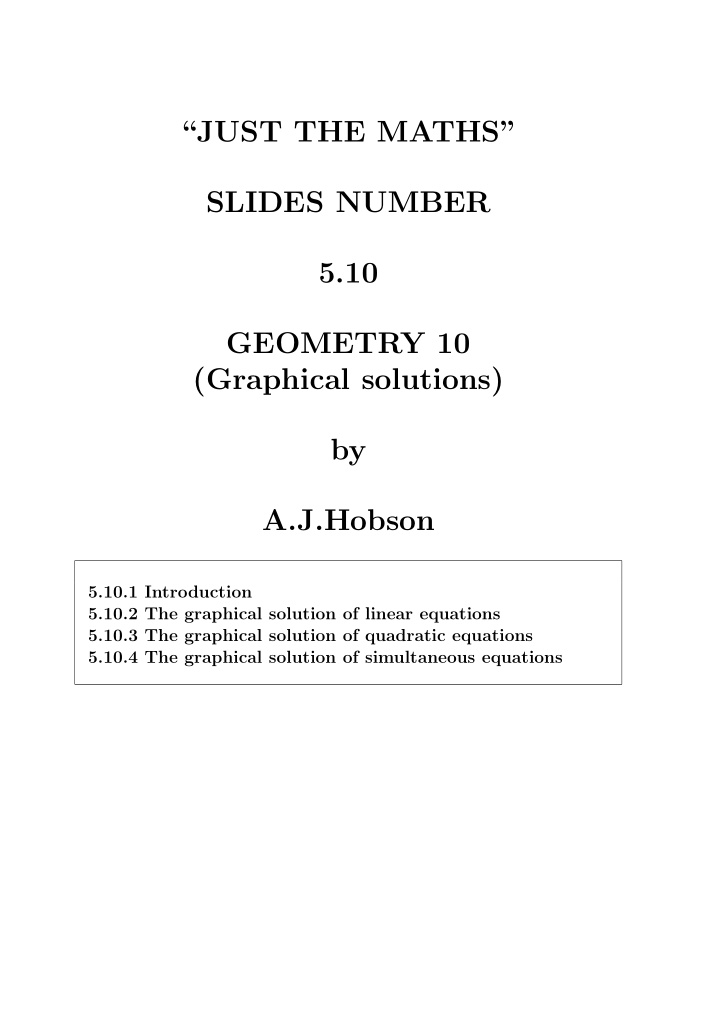



“JUST THE MATHS” SLIDES NUMBER 5.10 GEOMETRY 10 (Graphical solutions) by A.J.Hobson 5.10.1 Introduction 5.10.2 The graphical solution of linear equations 5.10.3 The graphical solution of quadratic equations 5.10.4 The graphical solution of simultaneous equations
UNIT 5.10 - GEOMETRY 10 GRAPHICAL SOLUTIONS 5.10.1 INTRODUCTION An algebraic equation in a variable quantity, x , may be written in the general form f ( x ) = 0 where f ( x ) is an algebraic expression involving x ; we call it a “function of x ” ; (see Unit 10.1). In the following, f ( x ) will be either (a) a linear function of the form ax + b , where a and b are constants, or (b) a quadratic function of the form ax 2 + bx + c where a , b and c are constants. The solutions of the equation f ( x ) = 0 are those values of x which cause f ( x ) to take the value zero. The solutions are also the values of x for which the graph of the equation y = f ( x ) meets the x -axis. 1
5.10.2 THE GRAPHICAL SOLUTION OF LINEAR EQUATIONS To solve the equation ax + b = 0 , we may plot the graph of the equation y = ax + b to find the point at which it meets the x -axis. EXAMPLES 1. By plotting the graph of y = 3 x − 5 from x = 0 to x = 3, solve the linear equation 3 x − 5 = 0 . Solution 0 1 2 3 x y − 5 − 2 1 4 ✂ y ✂ ✻ ✂ ✂ ✂ ✂ 5 ✂ ✲ x 3 O ✂ 3 ✂ ✂ ✂ ✂ ✂ − 5 Hence x ≃ 1 . 7 2
2. By plotting the graph of y = 2 x + 7 from x = − 4 to x = 2, solve the linear equation 2 x + 7 = 0 . Solution x − 4 − 3 − 2 − 1 0 1 2 y − 1 1 3 5 7 10 11 ✁ ✁ y ✁ ✻ ✁ ✁ ✁ − 7 ✁ 2 ✲ x ✁ O − 4 2 ✁ ✁ ✁ ✁ Hence x = − 3 . 5 3
5.10.3 THE GRAPHICAL SOLUTION OF QUADRATIC EQUATIONS To solve the quadratic equation ax 2 + bx + c = 0 , we may plot the graph of the equation y = ax 2 + bx + c and determine the points at which it crosses the x -axis. Alternatively, we may plot the graphs of y = ax 2 + bx and y = − c to determine their points of intersection. The alternative method is convenient since the first graph passes through the origin. EXAMPLE By plotting the graph of y = x 2 − 4 x from x = − 2 to x = 6, solve the quadratic equations, (a) x 2 − 4 x = 0; (b) x 2 − 4 x + 2 = 0; (c) x 2 − 4 x − 1 = 0 . 4
Solution x − 2 − 1 0 1 2 3 4 5 6 y 12 5 0 − 3 − 2 − 3 0 5 12 For parts (b) and (c), we shall also need the graphs of y = − 2 and y = 1. y ✻ ( − 0 . 2 , 1) (4 . 2 , 1) ✲ (4 , 0) x O (0 . 6 , − 2) (3 . 4 , − 2) Hence the three sets of solutions are: (a) x = 0 and x = 4; (b) x ≃ 3 . 4 and x ≃ 0 . 6; (c) x ≃ 4 . 2 and x ≃ − 0 . 2 5
5.10.4 THE GRAPHICAL SOLUTION OF SIMULTANEOUS EQUATIONS Problem To solve either a pair of simultaneous linear equations or a pair of simultaneous equations consisting of one linear and one quadratic equation. EXAMPLES 1. By plotting the graphs of 5 x + y = 2 and − 3 x + y = 6 from x = − 2 to x = 2, determine the common solution of the two equations. Solution − 2 − 1 0 1 2 x y 1 = 2 − 5 x 12 7 2 − 3 − 8 y 2 = 6 + 3 x 0 3 6 9 12 y ❆ ✻ ✂ ✂ ❆ ✂ ❆ ✂ ❆ ✂ ❆ ✂ ❆ ✂ ❆ ✂ ❆ ✂ ❆ ✂ − 2 2 ❆ ✲ ✂ x O ❆ ✂ ❆ ✂ ✂ ✂ ✂ ✂ ✂ Hence x = − 0 . 5 and y = 4 . 5 6
2. By plotting the graphs of the equations y = x 2 and y = 2 − 3 x from x = − 4 to x = 2, determine their common solutions and hence solve the quadratic equa- tion x 2 + 3 x − 2 = 0 . Solution − 4 − 3 − 2 − 1 0 1 2 x y 1 = x 2 16 9 4 1 0 1 4 y 2 = 2 − 3 x 14 11 8 5 2 − 1 − 4 y PPPPPPPPPPPPPPPPPPPPPP ✻ ✲ x O − 3 . 6 0.6 P Hence x ≃ 0 . 6 and x ≃ − 3 . 6 7
Recommend
More recommend